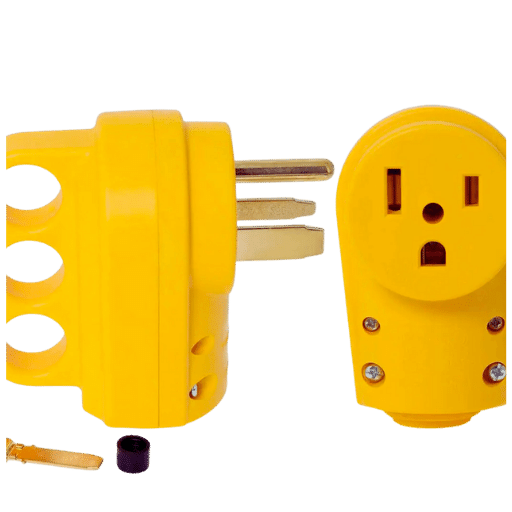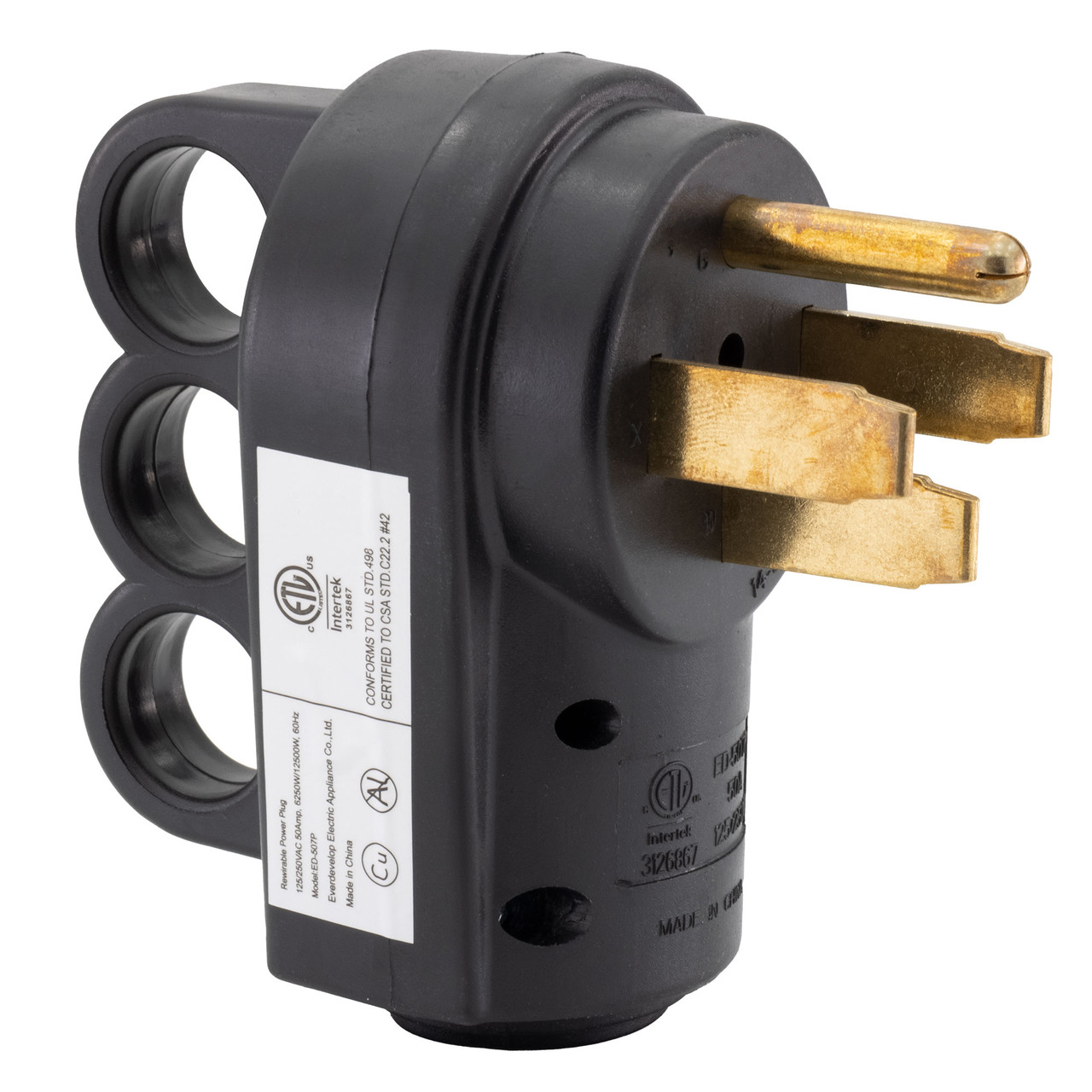A 50 amp RV plug is the standard power connector for large recreational vehicles, motorhomes, and fifth wheels. It provides more capacity than 20 amp or 30 amp plugs, supporting multiple high-wattage appliances. The plug follows the NEMA 14-50R specification and is designed for durability, safety, and heavy-duty power delivery.

What is a 50 Amp RV Plug?
A 50 amp RV plug is a four-prong connector built for recreational vehicle power systems. The plug delivers split-phase electricity, giving access to two independent 120-volt lines. This design makes it possible to power appliances like:
-
Two or more air conditioners
-
Residential refrigerators
-
Washers and dryers
-
Electric water heaters
-
Convection ovens and microwaves
The 50 amp RV plug is part of the National Electrical Manufacturers Association (NEMA) standard, commonly used for RV shore power, EV charging, and heavy equipment.
Anatomy of a 50 Amp RV Plug
Clear design elements define a 50 amp RV plug:
-
Prongs: Four prongs – Hot 1 (L1), Hot 2 (L2), Neutral, Ground
-
Breaker connection: Double-pole 50 amp breaker
-
Wire gauge: 6 AWG copper or 4 AWG aluminum
-
Voltage capacity: 125/250 volts AC
-
Power output: Up to 12,000 watts continuous load
This configuration ensures a safe flow of electricity from pedestal to RV distribution panel.
Electrical Capacity Explained
A 50 amp RV plug supplies 12,000 watts of power. Calculation:
-
50 amps × 120 volts × 2 hot legs = 12,000 watts
Comparison with smaller connections:
| RV Service | Voltage | Amps | Total Wattage | Typical Use Case |
|---|---|---|---|---|
| 20 Amp | 120 V | 20 A | 2,400 W | Small campers |
| 30 Amp | 120 V | 30 A | 3,600 W | Mid-size RVs |
| 50 Amp | 120/240 V | 50 A ×2 | 12,000 W | Large motorhomes |
Difference Between 30 Amp and 50 Amp RV Plugs
Clear difference exists between 30 amp and 50 amp service.
-
30 Amp Plug
-
Three prongs: Hot, Neutral, Ground
-
Supports up to 3,600 watts
-
Limits high-power appliances
-
-
50 Amp Plug
-
Four prongs: Two Hot legs, Neutral, Ground
-
Provides up to 12,000 watts
-
Runs multiple appliances simultaneously
-
Conclusion: A 50 amp plug is more than three times as powerful as a 30 amp plug, making it ideal for luxury RVs.
How to Install a 50 Amp RV Outlet at Home
To install a 50 amp outlet:
-
Choose the receptacle: Select a NEMA 14-50R outdoor-rated receptacle.
-
Install breaker: Use a double-pole 50 amp breaker in the main panel.
-
Wire correctly: Use 6 AWG copper or 4 AWG aluminum conductors.
-
Mount enclosure: Use a weatherproof box with a hinged cover.
-
Follow code: Ensure compliance with NEC and local building codes.
-
Hire electrician: Professional installation prevents hazards.
Using Adapters with a 50 Amp RV Plug
Adapters are common in campgrounds. However, power is limited by the pedestal:
-
50 to 30 adapter: Only 3,600 watts available
-
50 to 20 adapter: Only 2,400 watts available
-
30 to 50 adapter: RV still restricted to 30 amp capacity
Important: Adapters change the plug shape, not the available amperage.
Extension Cords and Cable Ratings
A 50 amp RV extension cord is essential for long-distance hookups. Key details:
-
Length: Typically 25–50 feet
-
Wire size: 6/3 + 8/1 configuration
-
Rating: UL-certified for outdoor use
-
Safety: Avoid undersized cords to prevent overheating
Safety Tips for Using a 50 Amp RV Plug
-
Check pedestal wiring before connecting.
-
Use surge protection or an EMS unit.
-
Inspect plugs for corrosion or heat damage.
-
Keep connections tight to prevent arcing.
-
Never overload circuits with high-demand appliances.
Common Misconceptions
-
“A 50 amp RV plug always provides 240 volts.”
-
Reality: Most RVs use two 120-volt legs. Only specific appliances may use 240 volts.
-
-
“Adapters increase available power.”
-
Reality: Amperage is limited by the source, not the adapter.
-
-
“All RVs need 50 amp plugs.”
-
Reality: Small and mid-size RVs function with 30 amp or even 20 amp service.
-
50 Amp RV Plug vs EV Charging
The NEMA 14-50 outlet is also a standard for Level 2 electric vehicle charging. EV chargers typically draw 32–40 amps at 240 volts, which overlaps with RV use. Many campgrounds now support EV charging at RV pedestals.
Maintenance Best Practices
-
Inspect outlets twice yearly.
-
Replace cracked or overheated plugs.
-
Apply dielectric grease to prevent corrosion.
-
Keep cords clean and dry.
-
Store cords coiled without kinks.
-
Test GFCI and breakers regularly.
Troubleshooting 50 Amp RV Plug Issues
-
Breaker trips: Caused by overload or wiring fault.
-
Dim lighting: Low voltage at pedestal or damaged cord.
-
Hot plug ends: Poor contact or undersized cable.
-
Neutral problems: Voltage imbalance across legs damages appliances.
Advantages of a 50 Amp RV Plug
-
Supports high-powered appliances.
-
Provides redundancy with two hot legs.
-
Compatible with EV charging.
-
Reduces risk of overloading.
-
Widely available at RV parks.
Disadvantages of a 50 Amp RV Plug
-
Requires heavier, costlier cords.
-
Needs professional installation at home.
-
Heavier adapters and equipment.
-
More complex electrical distribution inside RV.
Best Practices for Campground Hookups
-
Test pedestal with a voltmeter.
-
Connect surge protector before plugging RV.
-
Ensure breakers are off before plugging in.
-
Balance appliance use across both legs.
-
Disconnect in reverse order when leaving.
Checklist Before Using a 50 Amp RV Plug
-
Verify receptacle type (NEMA 14-50R).
-
Confirm breaker size (50 amp, double pole).
-
Inspect wire gauge (6 AWG copper).
-
Test pedestal voltage (120 volts per leg).
-
Attach surge protection device.
Essential Gear for 50 Amp RV Owners
-
Heavy-duty 50 amp extension cord
-
50 amp surge protector or EMS
-
50 to 30 amp adapter
-
50 to 20 amp adapter
-
Weatherproof outlet cover
-
Digital multimeter
Common Appliances Powered by 50 Amp RV Plug
-
Dual air conditioning units
-
Residential refrigerator
-
Microwave oven
-
Washer and dryer
-
Water heater
-
Induction cooktop
FAQs About 50 Amp RV Plug
Q1. Can a 50 amp RV plug run a house temporarily?
Yes, with a transfer switch, it can power essential loads.
Q2. What wire size is required for a 50 amp RV outlet?
6 AWG copper or 4 AWG aluminum is required.
Q3. Do all RVs with 50 amp service use 240 volts?
No, most distribute two 120-volt legs separately.
Q4. Is a GFCI breaker necessary for a 50 amp outlet?
Yes, in some residential installs, GFCI is required by code.
Q5. Can I use a 50 amp RV plug for a Tesla charger?
Yes, most EV chargers are compatible with NEMA 14-50 outlets.
Learn More: 13 Weeks From Today: Complete Guide to Dates, Planning, and Practical Uses
32 oz of Water: Complete Guide to Conversion, Hydration, and Health
Conclusion
The 50 amp RV plug is the backbone of modern RV power systems. With its 12,000-watt capacity, it supports all major appliances in large RVs. Safe installation, correct wire size, and surge protection are essential for reliability. Whether used in campgrounds, at home, or for EV charging, the 50 amp RV plug ensures steady, high-capacity power.

